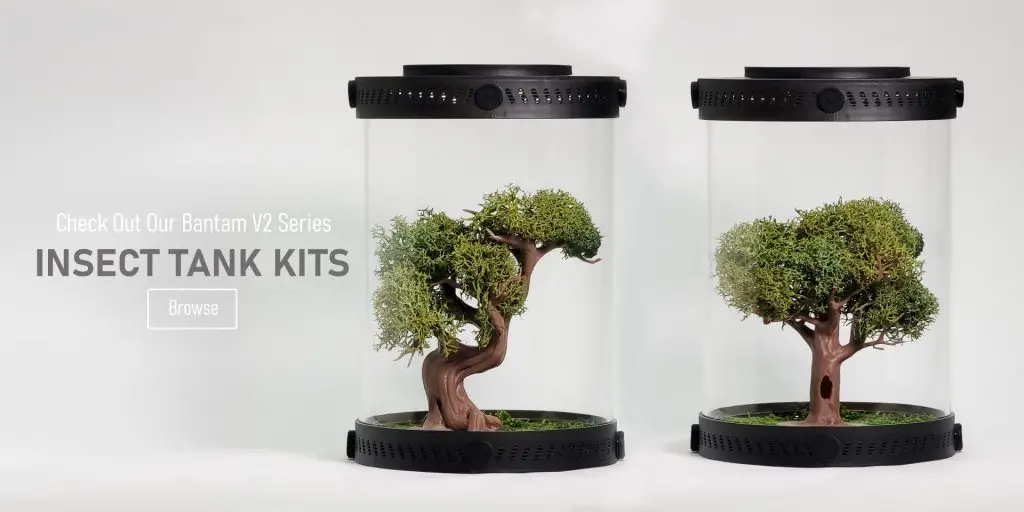The iridescent bark mantis is easily the most exotic-looking mantis on our list of praying mantes. At first glance, many beginners might even assume it’s something else entirely.
Native to Singapore and the Philippines, they are a unique species with a beautiful sheen coating their bodies.
They are a popular species to keep as pet mantids, due to their relatively easy care routine.
Read on to learn all about caring for Metallyticus splendidus.
Table Of Contents:
ToggleWhat Are Iridescent Bark Mantis?
Metallyticus splendidus is the only member of the mantis family Metallyticidae and is also sometimes referred to as the iridescent bark mantis or the rainbow bark mantis.
The scientific name Metallyticus splendidus comes from the words metallics (referring to their bright colors) and splendidus (referring to their remarkable beauty).
The common name comes from the unique iridescent colors of the mantis which can vary in hue depending on the angle of light.
They have a delicate tracery on their wings and a sheen that radiates from their bodies.
What Does Iridescent Bark Mantis Look Like?
Metallyticus splendidus is an eye-catching bug. When fully grown, they measure about two inches long.
Iridescent bark mantises are usually different shades of green, and can sometimes have a pinkish-red hue.
As their name suggests, they have a metallic sheen to their bodies that reflects the colors of the rainbow.
They have two large compound eyes along with their raptorial forelegs that are used for grasping prey and their long antennae that help them detect their prey.
These mantises are also named because they can be found living among bark in the rainforest.
Benefits Of Using Iridescent Bark Mantis
The iridescent bark mantis makes for a great inhabitant of any vivarium, as they offer vibrant colors and interesting behavior.
Not only that, but they help with pest control – their predatory habits mean that they will help you keep your enclosure clean by reducing the number of insects.
They are also relatively easy to care for, making them ideal for beginner enthusiasts.
In addition to their low maintenance requirements, these mantises also provide a captivating display, with their iridescent coloration and unique looks.
If you’re looking for a beautiful, low-maintenance species to add to your terrarium, the rainbow bark mantis could be the perfect inhabitant for you!

Iridescent Bark Mantis Facts
The iridescent bark mantis is a stunning species native to Southeast Asia.
They are typically quite docile in temperament, and have a natural diet that consists of other small insects.
If given the proper care, they can thrive for upwards of one year and can be bred in captivity with the right conditions.
Habitat
The iridescent bark mantis is native to Singapore and the Philippines in Southeast Asia.
They mainly inhabit tropical rainforests, where the temperature and humidity are more similar to their native environment.
In their natural environment, they are found among the forest floors, in the trees, and even on mossy surfaces.
They are nocturnal insects, meaning they are active at night and sleep during the day.
Metallyticus splendidus is well adapted to its environment.
It has a special coloration, which helps them camouflage within the foliage of their natural environment.
Create the perfect home for your mantis with our Customizable Mantis Enclosure Kits, designed to meet all their habitat needs.
Diet
In their natural habitat, Metallyticus splendidus are consummate predators, making up the majority of their diet.
Wild iridescent bark mantis individuals typically feed on other insects such as flies, moths, beetles, or even other mantises.
Their diet also includes the occasional spider, earwig, and even the occasional lizard and small fish.
Wild rainbow bark mantises have been known to feed on dead animal matter or decaying plant material as well.
They have excellent vision and hearing, which use to hunt their prey.
They typically ambush their prey with lightning speed, trapping and consuming unsuspecting bugs with their formidable spines and powerful front legs.
To find prey, Metallyticus splendidus rely heavily on their superior four eyes.
These eyes are segmented into three sections; two are used for light-sensitive detection, one for detail spotting, and one below the pair of eyes is used for polarized light detection.
This set of eyes allows the mantis to hone in on their prey with unwavering accuracy.
Temperament
Metallyticus splendidus are generally peaceful animals and do not have any ill will towards humans.
They may startle and flutter their wings if they are startled but won’t be aggressive at all.
As for other animals, the iridescent bark mantis will react only if they feel threatened.
They will raise their wings and sometimes strike predators with their long, powerful forelegs.
However, since they usually shy away from most animals, these behaviors are usually defensive rather than offensive.
The rainbow bark mantis is a social creature and will often interact with other mantises in its space.
Lifespan
The average life span of Metallyticus splendidus is eight to twelve months. However, with proper care, some individuals can live longer.
Their life cycles are divided into four consecutive stages: egg, nymph, subadult, and adult.
After an egg is laid, it will typically take 3-5 months for it to hatch, depending on the temperature.
The newly hatched mantes are approximately 2-3 mm in size. After the molt to the nymph stage, the individuals will grow substantially, up to a few centimeters.
After several more molts, they will reach adulthood, usually when they can no longer molt.
Adult females will lay eggs closer to the end of their life cycle, usually anywhere from 20-50 at a time.
After egg laying, the female will die, usually within a month.
For males, it is not uncommon for them to survive for several months after reaching adulthood.
Breeding
Metallyticus splendidus reproduces through a process of egg-laying.
In this process, the female will lay an egg sac (ootheca) containing dozens of tiny eggs.
The environment must be humid enough for the eggs to develop properly.
For optimal development, temperatures should range from 75 to 85 degrees Fahrenheit.
Once the mantis eggs have hatched, the nymphs (babies) will emerge and take on the characteristics of the species (dark-colored bodies, colorful details).
When the nymphs are big enough, they usually go through a few molts before they reach adulthood.
The males of the species are typically smaller than the females, with more defined features and bright markings.
Where To Find Iridescent Bark Mantis
Finding Metallyticus splendidus in the wild is possible, but it is much easier to find them in a pet store or online.
These mantis species are native to Singapore and the Philippines so you may be able to find them if you travel to those countries.
However, most pet stores in the United States and other parts of the world will more likely carry them or be able to order one for you.
When shopping for an Iridescent Bark Mantis, make sure that it is healthy and not stressed from the travel.
Check for signs of insect mites or fungus before you buy.
Iridescent Bark Mantis Care
Caring for Metallyticus splendidus requires providing the mantis with a clean housing environment with the correct humidity and temperatures, feeding it a varied diet, and monitoring its health and well-being.
Common health issues include dehydration and molting troubles which can easily be prevented by maintaining the proper environmental conditions.
Tank Requirements
When considering tank requirements for Iridescent Bark Mantis, the ideal vivarium type is a terrarium, as this setup offers the most naturalistic habitat.
The ideal range for pH should be between 6 and 7.5.
The best range for temperature should be between 75-85°F, and it is important to ensure the temperature does not drop below 65°F.
As far as substrate goes, peat moss or coco-fiber are great options for providing moisture and aeration.
The ideal terrarium lighting for these little bugs is an LED, CFL, or halogen light with a natural color temperature between 18000 and 25000K.
Additionally, the lighting should be on for 12-14 hours a day.
What Does Iridescent Bark Mantis Eat?
Feeding your Metallyticus splendidus is relatively easy, but here are some tips to keep in mind for optimal health.
Feeding them too frequently, or too little, can be detrimental to their health.
- Feed them insects twice per week, such as crickets, flies, moths, grasshoppers, etc.
- Make sure the size of the insects is appropriate for the size of the mantis.
- Dust the food with a vitamin/mineral supplement once per week.
- Offer a variety of insects since they are omnivorous.
- Feed them in a separate container so that they are not disturbed while eating.
If you’re looking for a more detailed approach to feeding these critters, be sure to check out my ultimate DIY Praying Mantis food guide. I give a more in-depth explanation of the best foods and my favorite recipe.
Best Tankmates For Iridescent Bark Mantis
When it comes to choosing the right tankmates for Iridescent Bark Mantises, you should avoid any species of mantis, as they may view each other as prey.
Instead, it is recommended to choose tankmates that share similar environmental and nutritional needs.
These can include small insects such as crickets, locusts, mealworms, and flies.
Additionally, you can also add some beneficial invertebrates such as isopods or springtails to enrich the tank and provide additional nutrition.
Isopods and springtails are also beneficial in that they act as janitors, helping to remove any debris or decaying matter in the tank.
Lastly, in a multi-terrain setup like a paludarium, you can also add some calm and mellow fish, such as guppies, which will provide interesting visuals as well as additional nutrition for the mantises.
Conclusion
Caring for an Iridescent bark mantis is not a difficult task, as long as you are familiar with their habitat, diet, and health concerns.
In addition to providing enrichment and stimulation, providing Metallyticus splendidus with the proper care is vital to ensuring its health and longevity.
With the right care and knowledge, you can ensure your pet mantis lives out its fullest and most vibrant life.
Create the ideal habitat for your praying mantis with our species-specific soil mixes and Insect Enclosure Kits. These products provide everything you need for a thriving Mantid habitat.
Frequently Asked Questions
Metallyticus Splendidus is approximately 1 to 2 inches in length.





